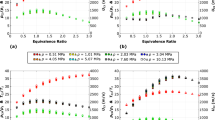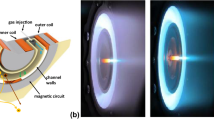Abstract
An accurate evaluation of the processes taking place from the spark onset until the flame self-propagates in spark ignition internal combustion engines would be very beneficial. It would provide engine designers with more reliable criteria, and this in turn would help lower harmful emissions and achieve improved energy utilization. In order to be computationally affordable, combustion codes contain models which simplify specific tasks. Particularly, the ignition process is very demanding in terms of computational cost, so ignition models are normally resorted to. Their accuracy heavily relies on the knowledge of the physics of the process and their simplifying hypothesis. Currently widely used low-dimensional models are perceived to oversimplify some essential features, perhaps being the most important the role of plasma hydrodynamics, which eventually defines the kernel shape. In this work the effect some fundamental parameters have on the whole process, such as electrode and spark gap dimensions, amount of discharged energy and initial chamber pressure and temperature, is simulated. A qualitative and quantitative analysis allows the assessment of a recently proposed low-dimensional thermodynamic model devised for fast discharges, and to establish its range of validity. Some modifications to this model are introduced in order to improve its predictive capabilities and to extend its range of applicability. Additionally, the effect of a further arc or glow discharge and the influence of electrode configuration asymmetry are simulated, providing a methodology to treat both cases.

















Similar content being viewed by others
References
Kono M, Kumagai S, Sakai T (1977) The optimum condition for ignition of gases by composite sparks. Symp (Int) Combust 16(1):757–766. https://doi.org/10.1016/S0082-0784(77)80369-X
Kravchik T, Sher E, Heywood JB (1995) From spark ignition to flame initiation. Combust Sci Technol 108(1–3):1–30. https://doi.org/10.1080/00102209508960387
Thiele M, Warnatz J, Maas U (2000) Geometrical study of spark ignition in two dimensions. Combust Theory Model 4(4):413–434. https://doi.org/10.1088/1364-7830/4/4/303
Akram M (1996) Two-dimensional model for spark discharge simulation in air. AIAA J 34:1835–1842. https://doi.org/10.2514/3.13315
Ekici O, Ezekoye O, Hall M, Matthews R (2007) Thermal and flow fields modeling of fast spark discharges in air. J Fluids Eng. 129 https://doi.org/10.1115/1.2375130
Borghese A, D’Alessio A, Diana M, Venitozzi C (1989) Development of hot nitrogen kernel, produced by a very fast spark discharge. Symp (Int) Combust 22(1):1651–1659. https://doi.org/10.1016/S0082-0784(89)80177-8
Colin O, Ritter M, Lacour C, Truffin K, Mouriaux S, Stepanyan S, Lecordier B, Vervisch P (2019) DNS and LES of spark ignition with an automotive coil. Proc Combust Inst 37(4):4875–4883. https://doi.org/10.1016/j.proci.2018.08.021
Maly R (1984) Spark Ignition: Its physics and effect on the internal combustion engine. In: Hilliard JC, Springer GS (eds) Fuel Economy in Road Vehicles Powered by Spark Ignition Engines. Springer, Boston, MA, pp 91–148
Sforzo B, Lambert A, Kim J, Jagoda J, Menon S, Seitzman J (2015) Post discharge evolution of a spark igniter kernel. Combust Flame 162(1):181–190. https://doi.org/10.1016/j.combustflame.2014.07.024
Choi CR, Huh KY (1998) Development of a coherent flamelet model for a spark-ignited turbulent premixed flame in a closed vessel. Combust Flame 114:336–348. https://doi.org/10.1016/S0010-2180(97)00194-6
Song J, Sunwoo M (2000) A modeling and experimental study of initial flame kernel development and propagation in SI engines. SAE Tech Pap 2000-01-0960 https://doi.org/10.4271/2000-01-0960
Lucchini T, Cornolti L, Montenegro G, D’Errico G, Fiocco M, Teraji A, Shiraishi T (2013) A comprehensive model to predict the initial stage of combustion in SI engines. SAE Tech Pap 1–1087:1–1087. https://doi.org/10.4271/2013-01-1087
Zhu X, Sforza L, Ranadive T, Lee S-Y, Naber J, Lucchini T, Onorati A, Anbarasu M, Zeng Y (2016) Experimental and numerical study of flame kernel formation processes of propane-air mixture in a pressurized combustion vessel. SAE Int J Eng 9 https://doi.org/10.4271/2016-01-0696
Sforza L, Lucchini T, Onorati A, Zhu X, Lee S-Y (2017) Modeling ignition and premixed combustion including flame stretch effects. SAE Tech Pap 01–0553 https://doi.org/10.4271/2017-01-0553
Meyer G, Wimmer A (2018) A thermodynamic model for the plasma kernel volume and temperature resulting from spark discharge at high pressures. J Therm Anal Calorim 133:1195–1205. https://doi.org/10.1007/s10973-018-7169-z
Refael S, Sher E (1985) A theoretical study of the ignition of a reactive medium by means of an electrical discharge. Combust Flame 59(1):17–30. https://doi.org/10.1016/0010-2180(85)90054-9
Alger T, Mangold B, Mehta D, Roberts C (2006) The effect of sparkplug design on initial flame kernel development and sparkplug performance. SAE Tech Pap 01–0224 https://doi.org/10.4271/2006-01-0224
Sher E, Ben-Ya’Ish J, Kravchik T (1992) On the birth of spark channels. Combust Flame 89(2):186–194. https://doi.org/10.1016/0010-2180(92)90027-M
Maly R, Vogel M (1979) Initiation and propagation of flame fronts in lean CH4-air mixtures by the three modes of the ignition spark. Symp (Int) Combust 17(1):821–831. https://doi.org/10.1016/S0082-0784(79)80079-X
Schäfer M, Schmidt R, Köhler J (1996) I-D simulation of a spark discharge in air. Symp (Int) Combust 26(2):2701–2708. https://doi.org/10.1016/S0082-0784(96)80106-8
Akindele OO, Bradley D, Mak PW, McMahon M (1982) Spark ignition of turbulent gases. Combust Flame 47:129–155. https://doi.org/10.1016/0010-2180(82)90097-9
Poinsot T, Veynante D (2012) Theoretical and Numerical Combustion, 3rd edn. Poinsot T. and Veynante D, Paris, France
D’angola A, Colonna G, Gorse C, Capitelli M (2008) Thermodynamic and transport properties in equilibrium air plasmas in a wide pressure and temperature range. Eur Phys J D 46:129–150. https://doi.org/10.1140/epjd/e2007-00305-4
Patankar SV (1980) Numerical Heat Transfer and Fluid Flow. Taylor & Francis, Boca Raton
Issa RI (1986) Solution of the implicitly discretised fluid flow equations by operator-splitting. J Comput Phys 62(1):40–65. https://doi.org/10.1016/0021-9991(86)90099-9
Capitelli M, Colonna G, Gorse C, D’angola A (2000) Transport properties of high temperature air in local thermodynamic equilibrium. Eur Phys J D 11:279–289. https://doi.org/10.1007/s100530070094
Au S, Haley R, Smy PR (1992) The influence of the igniter-induced blast wave upon the initial volume and expansion of the flame kernel. Combust Flame 88(1):50–60. https://doi.org/10.1016/0010-2180(92)90006-B
Arpaci V, Ko Y, Lim M, Lee H (2003) Spark kernel development in constant volume combustion. Combust Flame 135:315–322. https://doi.org/10.1016/S0010-2180(03)00169-X
Lim MT, Anderson RW, Arpaci VS (1987) Prediction of spark kernel development in constant volume combustion. Combust Flame 69(3):303–316. https://doi.org/10.1016/0010-2180(87)90123-4
Ko Y, Arpaci VS, Anderson RW (1991) Spark ignition of propane-air mixtures near the minimum ignition energy: Part II. Model Develop Combust Flame 83(1):88–105. https://doi.org/10.1016/0010-2180(91)90205-P
Herweg R, Maly RR (1992) A fundamental model for flame kernel formation in S. I Eng SAE Tech Pap 922243:1947–1976. https://doi.org/10.4271/922243
Forte C, Bianchi G.M, Corti E (2010) Validation of a lagrangian ignition model in SI engine simulations. In: Internal Combustion Engine Division (Publication) ICE. Am Soc Mech Eng San Antonio Texas USA 49446 859-871
Acknowledgments
This work has received financial support from Consejo Nacional de Investigaciones Científicas y Técnicas (CONICET, Argentina), Universidad Nacional del Comahue (UNCo, Argentina, grant PIN 04/I-251), Agencia Nacional de Promoción de la Investigación, el Desarrollo Tecnológico y la Innovación (Agencia I+D+i, Argentina, grant PICT 2018-2920), and Universidad Nacional del Litoral (UNL, Argentina, grant CAI+D 2020 506-201901-00110-LI), and was partially performed with the Free Software Foundation GNU-Project resources as GNU/Linux OS, GCC compilers, GNU/Octave, and GNUPlot, as well as other Open Source resources as OpenFOAM®, ParaView, and LaTeX, among many others.
Author information
Authors and Affiliations
Contributions
All authors contributed to the study conception and design. Material preparation, data collection and analysis were performed by Joaquín Aranciaga, Ezequiel J. López and Norberto M. Nigro. The first draft of the manuscript was written by Joaquín Aranciaga and all authors commented on previous versions of the manuscript. All authors read and approved the final manuscript.
Corresponding author
Additional information
Technical Editor: Mario Eduardo Santos Martins.
Publisher's Note
Springer Nature remains neutral with regard to jurisdictional claims in published maps and institutional affiliations.
Rights and permissions
Springer Nature or its licensor (e.g. a society or other partner) holds exclusive rights to this article under a publishing agreement with the author(s) or other rightsholder(s); author self-archiving of the accepted manuscript version of this article is solely governed by the terms of such publishing agreement and applicable law.
About this article
Cite this article
Aranciaga, J., López, E.J. & Nigro, N.M. On post-breakdown initialization for ignition models. J Braz. Soc. Mech. Sci. Eng. 44, 579 (2022). https://doi.org/10.1007/s40430-022-03886-0
Received:
Accepted:
Published:
DOI: https://doi.org/10.1007/s40430-022-03886-0




